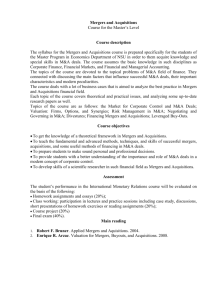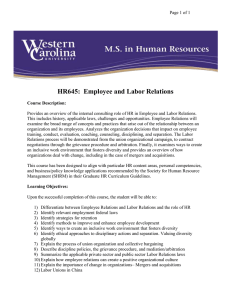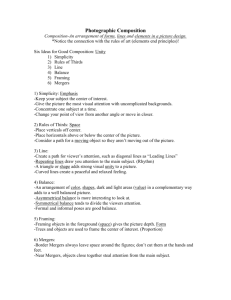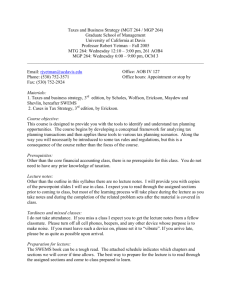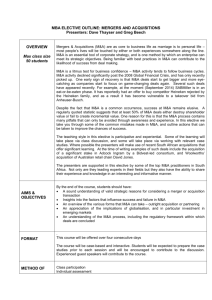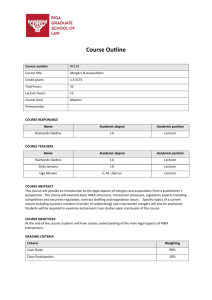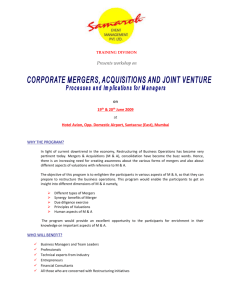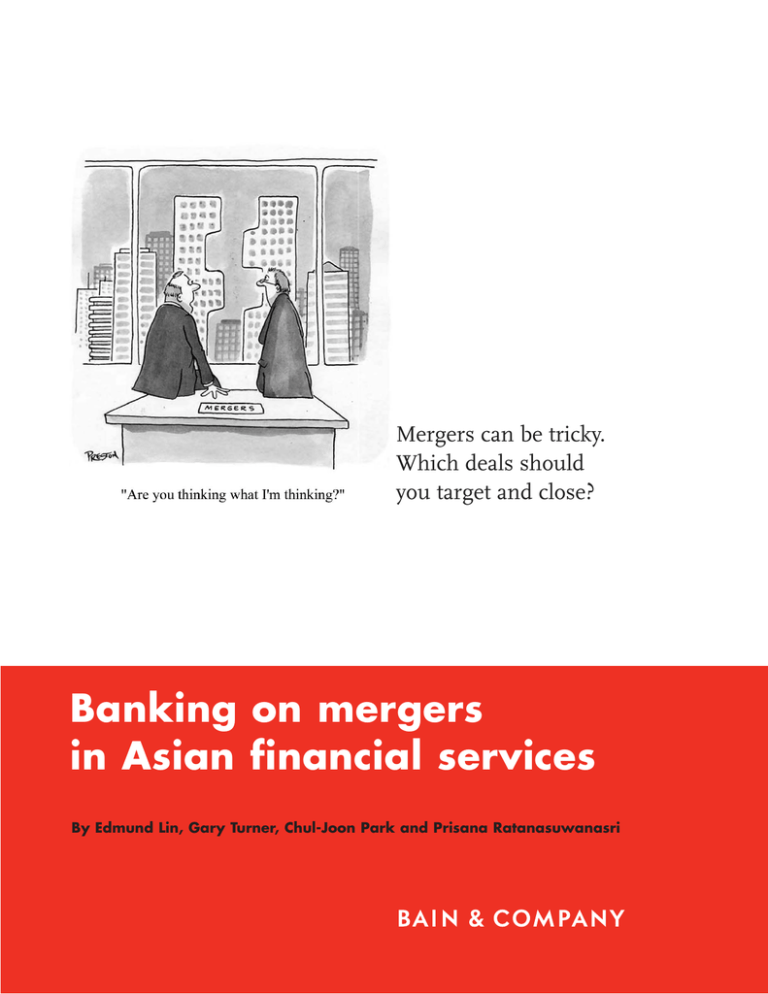
Mergers can be tricky.
Which deals should
you target and close?
Banking on mergers
in Asian financial services
By Edmund Lin, Gary Turner, ChulJoon Park and Prisana Ratanasuwanasri
Banking on mergers in Asian financial services
Mergers can be tricky.
Which deals should
you target and close?
From Beijing to Bangalore and Sydney to
Seoul, deal fever is gripping Asia’s financial
services sector. The total value of mergers
and acquisitions of banks, brokerages and
insurers across Asian-Pacific markets topped
$30 billion in 2005, making it the secondbusiest year for M&A activity in the past
decade. Notably, international investors have
been staking out positions in the world’s
fastest-growing economies: Cross-border deals
accounted for better than three-quarters
of the value of all M&A activity last year.
International private equity funds, with more
than $100 billion to deploy across the region,
have been especially active, accounting for
nearly a quarter of total recent deal value.
(See figure 1.)
Growth in national markets
Changes are sweeping financial services
in national markets as varied as South Korea
and Australia—and they are quickening the
pulses of potential acquirers. (See sidebar,
“A buyer’s market in Asia,”on next page.)
No market has exerted a more powerful draw
than China, where the value of cross-border
financial services acquisitions jumped 67% in
2005, to more than $15 billion. The upsurge is
powered in large part by investors scrambling
to forge alliances with local banks, insurance
companies and fund managers before
China opens its financial services sector
to international competition under World
Trade Organization rules in 2007. Also
feeding the M&A appetite, the China Banking
Regulatory Commission recently lifted the
cap on foreign ownership stakes, from 15%
to 20%. That move will enable international
investors to exert increased control over their
equity partners.
Figure 1: Crossborder deal activity is increasing
Value of financial services acquisitions (US$ billions)
(AsiaPacific region, excluding Japan)
Domestic
$50
Across borders
$40B
$40
$31B
$30
$26B
76%
$19B
$20
69%
79%
34%
$11B
$10
66% $5B
31%
37%
$2B
$3B
63%
39%
95
96
97
98
$0
55%
45%
99
$20B
$20B
45%
48%
77%
61%
69%
23%
$25B
21%
00
24%
31%
01
02
55%
52%
03
04
05
Sources: Mergers & Acquisitions Asia Journal, Bloomberg
1
Banking on mergers in Asian financial services
A buyer’s market in Asia
The lure of Asian financial services companies is hard to resist—and buoyant economic
growth is by no means their sole appeal. Attractive valuations have acquirers feeling the
pressure to act while conditions are ripe. Shares of Asian financial companies, as measured
by the Morgan Stanley Capital International (MSCI) Index, have rebounded sharply from their
nadir in late 2001. Over the four years ending in late 2005, the MSCIAsia index of financial
services companies has doubled. Meanwhile, the financial sector’s pricetoearnings ratios
dropped across all major regional economies over the same period, making acquisitions
a relative bargain.
Figure 2: Financial sector
stocks are rising...
...but declining valuations may spur
more deal activity
MSCI Financials indices
for Asia
Financial services industry
pricetoearnings ratio
30
150
Taiwan
Hong Kong
100
20
Southeast Asia
India
Australia
50
10
0
South Korea
0
Jan
Dec
2002
2003
2004
2005
00 01 02 03 04 05 05
Note: Morgan Stanley Capital International performance indexed to 100 in January 2000; Southeast Asia pricetoearnings
ratio is the weighted average for 27 banks and financial institutions across Indonesia, Malaysia, Philippines, Singapore,
and Thailand
Sources: Bloomberg; JPMorgan Asia Pacific Equity Research
2
Banking on mergers in Asian financial services
The merger trend is likely to remain strong
as China taps foreign capital and looks for
ways to strengthen its companies’ capabilities
as it pushes toward economic power.
In South Korea, deregulation and competitive
pressures are also intensifying deal activity
in financial services. Korean reforms put in
place in the aftermath of the 1997 currency
crisis have led to a fundamental restructuring
of the banking sector. Financial institutions
have shifted their focus from lending to the
industrial chaebols to instead serving increasingly affluent savers and investors. In the
past three years, Korean retail banks have
seen rapid consolidation—the four largest
institutions now control more than 75% of
the market. But there’s still plenty of room
for additional merger-fueled growth in the
insurance and brokerage sectors. South Korean
institutions are just beginning to tap the
market for managing the assets of the nation’s
savers and investors, and they will likely be
eager to team up with seasoned partners.
China’s burgeoning population
of urban workers and energetic
entrepreneurs are hungry for
banking products, making
financial services one of the
hottest sectors of growth in the
Chinese economy.
In Australia, regulatory changes, increasing
penetration by foreign banks and a demographic tilt toward older, more affluent
consumers are sparking merger interest
Down Under. The competition for aging
Aussies’ business has driven down interest-rate
spreads and narrowed profit margins, forcing
banks to rein in costs. Although government
policy currently prevents Australia’s “Big Four”
banks from merging, domestic institutions are
collaborating in joint ventures to create new
efficiencies for certain back-office functions
such as check processing. Nevertheless,
pressure to merge continues to build among
Australia’s remaining regional banks, and
the bigger banks are expected to become
more attractive to large overseas acquirers
as competition heats up.
The M&A paradox
For all of the Asian financial sector’s attractions, would-be acquirers face a stark reality:
The M&A route may be the quick way to gain
a foothold in the region’s promising future,
but in the end, most mergers fail to create
value for shareholders. In fact, the stock price
of the median acquirer is typically 12% below
the index of its peers one year after the deal
has been announced, according to data on
financial industry mergers from an ongoing
global analysis of M&A activity by Bain &
Company. Mergers with Asian financial
services companies in particular face even
more daunting challenges. Many of them
are undercapitalized, and they often suffer
operational shortcomings, lack of transparency
or nonperforming loans. Indeed, when Bain
evaluated 105 domestic and cross-border
deals completed between 1998 and 2003,
we found that in nearly 60% of those transactions the acquirer’s stock price underperformed
the index benchmark both 12 months and
then 24 months after the mergers were
announced. In just 14 of those deals did the
acquirer’s stock outperform the broader index
by 10% or more. Only private equity investors
3
Banking on mergers in Asian financial services
have consistently turned in market-beating
results. Among them, the average realized
internal rate of return for the private equity
deals was 21%, versus just an 8.6% gain
in the share price of public companies.
(See figures 3 and 4.)
Why such bleak results? It’s difficult to make
the right calls consistently about acquisition
targets. In fact, it is one of the biggest challenges executives face. When Bain surveyed
250 senior managers with M&A responsibilities, half said their due diligence process had
failed to uncover major problems. Two-thirds
said they routinely overestimated the synergies
available from acquisitions. A third acknowledged that, despite nagging doubts, they
hadn’t walked away from problematic deals.
Misgivings such as those are only magnified
when acquirers target financial companies
in markets—like many in Asia—that lack
Figure 3: Acquirer’s total shareholder
return vs. peer indices*
Distribution of rates of return for mergers & acquisitions,
1998–2003 (AsiaPacific region, excluding Japan)
105 deals
100%
80%
10% – 30%
Our work with clients shows that successful
merger deals follow a four-step process for
identifying, vetting and integrating potential
acquisitions that significantly improves their
chances of success:
Pick the right targets
For would-be acquirers, Asia’s financial services sector presents a target-rich environment.
But for cross-border dealmakers especially,
the sector proves to be a potentially perilous
arena that needs careful evaluation to size
up how companies compete. Successful deals
begin with a sound investment thesis—a
statement based on a clear growth strategy
that describes how a particular merger will
Figure 4: Private equity investments
outperform strategic ones
Distribution of rates of return for mergers & acquisitions,
1998–2003 (AsiaPacific region, excluding Japan)
105 deals
>30%
>30%
transparency or operate under regulatory
and accounting rules only now beginning to
conform to internationally accepted standards.
5 deals
113 deals
100%
>30%
80%
10% – 30%
10% – 30%
>30%
60%
40%
0% to 10%
10% – 0%
0% to 10%
60%
10% – 0%
40%
30% to 10%
20%
0% to 10%
10% – 30%
20%
30% to 10%
< 30%
0%
12 months
1.5%
10% – 0%
0% to 10%
< 30%
< 30%
30% to 10%
0%
24 months
Private equity investments*
0.1%
Median performance
Strategic investments ‡
21.0%
8.6%
Median performance
*Starting from one week before deal announcement
Source: Bain Asia FSI Deal Success Study (2005)
Source: Bain Asia FSI Deal Success Study (2005)
*Realized internal rate of return
Cumulative annual change of acquirer’s total shareholder return over 36 months
‡
4
Banking on mergers in Asian financial services
enhance the acquirer’s core strengths and
create value for the merged company. The
sharpest acquirers cast a wide net, eyeing a
range of possible candidates but pursuing
only those they can get to know intimately.
They focus on identifying the right-size
deals, beginning with smaller transactions
and building up to larger ones as they
develop their expertise.
Commonwealth Bank of Australia (CBA)
weighed its options carefully before placing
three modest—but promising—bets on
China’s retail and small-business banking
market. It found China’s burgeoning
population of urban workers and energetic
entrepreneurs hungry for banking products,
making financial services one of the hottest
sectors of growth in the Chinese economy.
The institutions now serving those markets—
the 112 government-owned “city commercial
banks”—enjoy privileged access to a major
metropolis and its surrounding province.
They are historically governed more by
bureaucratic fiat than sound business principles, however, and find themselves saddled
with bad debt and inefficient management
systems. Finding the few potential stars in
this opaque constellation requires a patient
and comprehensive approach.
CBA quickly recognized that the brightest
prospects would be in China’s 29 tier-one
cities—the country’s largest commercial
centers—and it concentrated on understanding those markets. After winnowing the long
list of potential candidates over the course of
two years, the Australian search committee
found a receptive welcome in Jinan, a rapidly
expanding industrial center in Shandong
Province located south of Beijing on China’s
east coast.
Following months of building trust with
their Chinese counterparts, CBA’s international development team had gotten to know
the Jinan market well enough to initiate an
agreement with Jinan City Commercial Bank
(CCB) in November 2004. Beginning with
an investment of just $17 million for 11%
of Jinan CCB, CBA secured a board seat
and an option to raise its holding to 20% by
mid-2008. The CBA investment lifted Jinan
CCB’s capital adequacy ratio a full percentage
point, to a healthy 10.3%, which was well
above the 8% minimum required under
Bank for International Settlements guidelines
and far outstripped the 6.1% average for all
Chinese city commercial banks at that time.
The M&A route
may be the
quick way to
gain a foothold
in Asia’s prom
ising future,
but in the end,
most mergers
fail to create
value for
shareholders.
Applying what was learned from its Jinan
due diligence, CBA was ready to make
a second and larger move in April 2005,
buying a 19.9% stake in Hangzhou City
Commercial Bank—one of China’s top five—
for $75.5 million. Again, strategic fit was key
to the deal, and CBA took the time to build
a relationship step-by-step over the course
of 12 months. In a parallel move, CBA
also purchased a Shanghai-based mortgage
brokerage business from Australian rival,
Macquarie Bank, in an effort to strengthen
its position with both of its China banking
deals and give it a leg up in China’s nascent
real estate–lending industry. Together, the
investments gave CBA a solid, but low-cost,
platform on which to build a profitable
China future.
5
Banking on mergers in Asian financial services
Know when to walk away
Successful dealmakers carefully test their
investment thesis by building a bottom-up
view of their target company to determine its
stand-alone value. The due diligence process
is no mere “check the box” formality for them.
By understanding the target company’s capabilities, competitors, customer base and cash
flow, they evaluate whether—and when—true
synergies can be achieved if the deal moves
forward. But they also predetermine the criteria that would cause them to walk away if
due diligence issues surface, and they actively
look for potential problems before the deal
is consummated. Among the warning signs:
overestimating a deal’s potential, being seduced
by a target company dressed up to look more
attractive than it really is and getting swept
up in the bidding process. Without a thorough
vetting and a readiness to pull the plug if
trouble appears, overeager acquirers are especially prone to falling into one of those snares.
With $750 million to invest across the region,
the veteran dealmakers at The Carlyle Group,
a prominent US private equity firm, have
been among the most active acquirers in Asia.
In addition to financial services investments
throughout the region, the list of companies
in which Carlyle has bought stakes runs the
gamut—from an artificial Christmas-tree
manufacturer based in Hong Kong and a
builder of industrial hoists in Japan to an
electronic billing-services provider in India
and an online travel agency headquartered in
Shanghai. What do these disparate holdings
have in common? For one thing, they all
survived a painstaking due diligence process
from a company renowned for its persnickety
deal-vetting discipline.
6
Before the firm will commit investors’ capital,
Carlyle’s partners limit any deal to an industry in which Carlyle can bring its expertise.
That intimate familiarity with local market
conditions and access to a network of global
resources gives Carlyle a clear competitive
edge. Because it is conservative in its use of
debt and insists that its partners invest their
personal funds alongside the firm’s outside
co-investors, Carlyle avoids getting swept up
in competitive auctions. The company takes a
pass on acquisitions that do not show potential for market leadership. Finally, it keeps an
eye firmly fixed on its exit strategy from the
outset. Identifying potential buyers at the end
of a typical three- to five-year holding period
is a core part of its due diligence process.
One recent acquisition that passed the firm’s
rigorous screening was the $410 million
investment concluded last December that
gave Carlyle a 25% share of China Pacific
Life Insurance (CPLI). As the largest private
equity transaction in China to date, the deal
has all the earmarks of a Carlyle classic. The
third-largest company in China’s fast-growing
life-insurance industry, Shanghai-based CPLI
commands an 11% share in a market where
the top-three insurers take in 80% of all
premiums. In addition to naming a new
management team, Carlyle further buffered
its investment risk by enlisting China Pacific
Insurance Group (CPIG)—CPLI’s holding
company parent—and US financial services
giant Prudential Financial as co-investors and
strategic partners. The matching investment
by CPIG aligns the parent company’s interests with Carlyle Group’s, and the strategic
involvement of Prudential makes the insurer
a likely buyer for Carlyle’s stake once the initial
work of building CPLI’s network is complete.
Banking on mergers in Asian financial services
Integrate where it matters
Effective integration generally ranks as the
single most important factor influencing
the success of a deal. It can make or break
a deal’s trajectory. Although every integration
project—like every merger—is different, a
number of guiding principles apply across
almost all integration efforts. They revolve
around one central issue: Where do operations truly need to be integrated, and where
can the merging businesses simply carry
on separately? Leaders of merged companies
put culture high on their leadership agenda,
retooling their corporate environment in
ways that are consistent with the deal’s
investment thesis. Whatever integration plan
they choose, they use hard tactics—organizational structure, compensation incentives and
the division of decision-making authority—
to address cultural integration.
With plenty of previous merger experience
under its belt, Singapore-based United
Overseas Bank (UOB) knew a thing or two
about successful post-merger integration by
the time it announced its biggest acquisition:
the $5.6 billion purchase of Overseas Union
Bank in late 2001. UOB Chairman and
CEO Wee Cho Yaw knew that the speedy
integration of the two institutions’ information technology systems would be crucial
to making the merged institution a premier
bank in the Asia-Pacific region. Few integration challenges are bigger than harmonizing
often incompatible legacy systems that touch
every critical aspect of a bank’s operations.
Success would depend on quickly developing
an effective collaboration among teams of
business and IT professionals. UOB estimated that integrating the two IT organizations
serving 365 offices around the world would
take a year and a half. In the end, the job
was done in just eight months.
Without a readiness to pull
the plug if trouble appears,
overeager acquirers are
especially prone to problems.
How did UOB do it? From the outset, top
management was involved in planning the
integration. The IT organization worked
hand-in-hand with their business unit colleagues, and a project management office
was established to coordinate all mergerrelated activities. To ensure that the bank’s
post-merger IT infrastructure had the scale
and capacity to support UOB’s goals, the
team sized up the capabilities of each bank’s
systems to determine which was better. Then,
instead of cherry-picking from both systems,
the team chose the better system—warts
and all—with the goal of quickly unifying
policies, processes and procedures. Using
this “choose-and-move” approach, the integration team completed 30 concurrent projects
and harmonized 100 major systems by June
2002, producing $140 million in annual
operating cost savings.
Expect the unexpected
No deal goes exactly as planned. Most company
leaders are blindsided by post-merger impediments; they’ve focused so hard on nailing
down the terms of the deal and hashing out
a broad integration plan that they’ve given
short shrift to spotting specific problems.
7
Banking on mergers in Asian financial services
But when execution of their post-merger
program veers off course, alert acquirers let
go of the past, admit errors and take tough,
decisive action to put their deals back on
track. Whether problems are manageable
or cataclysmic, successful acquirers have
strong early-warning systems in place to
identify difficulties, and they respond to even
the faintest distress signals without delay.
Opportunities for mishaps were rife when
Newbridge Capital—the Asian private equity
joint venture of Texas Pacific Group and
Blum Capital Partners—acquired Korea
First Bank from government receivership in
January 2000. In their first major foray into
North Asia, the new owners planned a major
makeover for Korea First, converting the
bankrupt commercial creditor into a retail
bank and small-business lender. Working
from a detailed blueprint, Newbridge and the
new management team aimed to reengineer
Korea First’s branch network, consolidating
back-office operations into two central customer
service centers and refocusing the front-line
personnel on boosting sales.
The plan was a tall order on all fronts, but
the key to its successful execution was not
the technological challenges, the asset redeployments or the operational reorientation.
The surprising “x-factor” Newbridge faced
was winning the confidence and support of
a workforce demoralized by bankruptcy and
bitter from successive rounds of layoffs.
Because the success of the bank’s restructuring hinged on defusing employee anxiety,
the new management team tapped key
human resources staffers from the outset
to help employees embrace change. They
built credibility with branch-office workers
by giving members of the change-manage-
8
ment team visibility throughout Korea First.
The team broadcast its commitment to retain
employees made redundant by downsizing,
and it helped steer displaced workers toward
training programs to prepare them for new
positions in customer service and sales. In
all, 800 jobs were lost due to branch closings
and streamlined work processes, but newly
created positions offset the losses. In addition, the candor and support—reinforced by
cash incentives for working smarter—helped
First Korea cut its loan approval time by 75%.
Regaining employee confidence proved a
winner. By 2005, the bank’s front- and backoffice infrastructure was considered best in
class by Korean standards, and its balance
sheet was the nation’s strongest. The ultimate
acknowledgment of this successful EastWest collaboration came when Standard
Chartered, the big British banking group,
purchased Korea First for $3.25 billion, a
nearly fourfold return on the private equity
investors’ cash investment.
Negotiating the perilous straits of mergers
and acquisitions is becoming the new rite of
passage to riches in Asian financial services,
and as adventurers of the past have found,
there are no shortcuts to reaching them.
Only by embarking on a disciplined voyage
of discovery, remaining vigilant to the risks
of unfamiliar territory and carefully husbanding resources will the M&A journey
yield its rewards.
Banking on mergers in Asian financial services
Bain’s business is helping make companies more valuable.
Founded in 1973 on the principle that consultants must measure their success in terms
of their clients’ financial results, Bain works with top management teams to beat competitors
and generate substantial, lasting financial impact. Our clients have historically outperformed
the stock market by 4:1.
Who we work with
Our clients are typically bold, ambitious business leaders. They have the talent, the will
and the open-mindedness required to succeed. They are not satisfied with the status quo.
What we do
We help companies find where to make their money, make more of it faster and sustain
its growth longer. We help management make the big decisions: on strategy, operations,
technology, mergers and acquisitions and organization. Where appropriate, we work with
them to make it happen.
How we do it
We realize that helping an organization change requires more than just a recommendation.
So we try to put ourselves in our clients’ shoes and focus on practical actions.
Edmund Lin is a partner based in Bain & Company’s Singapore office,
and heads the firm’s financial services practice area for Southeast Asia.
Gary Turner is a partner with Bain’s global financial services team based
in the firm’s Sydney office. Chul-Joon Park is coleader of Bain’s Asian private
equity practice and a member of the global financial services team based in
the firm’s Seoul office. Prisana Ratanasuwanasri is a manager in Bain’s
Singapore office.
Copyright © 2006 Bain & Company, Inc. All rights reserved.
Editorial team: Lou Richman, Elaine Cummings
Layout: Global Design
For more information, please visit www.bain.com
Cover cartoon © www.cartoonstock.com. All Rights Reserved.
Amsterdam • Atlanta • Beijing • Boston • Brussels • Chicago • Dallas • Düsseldorf • Hong Kong • Johannesburg • London
Los Angeles • Madrid • Melbourne • Mexico City • Milan • Munich • New York • Palo Alto • Paris • Rome • San Francisco
São Paulo • Seoul • Shanghai • Singapore • Stockholm • Sydney • Tokyo • Toronto • Zurich

